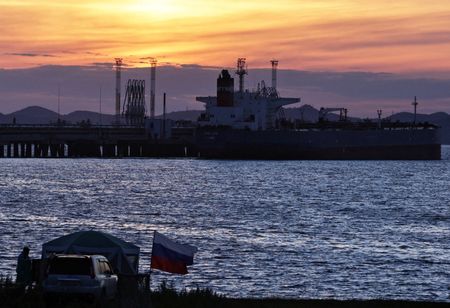
By Laila Kearney
NEW YORK (Reuters) -Oil was on track for a second straight annual gain in a turbulent year marked by tight supplies following the war in Ukraine, weakening demand from the world’s top crude importer China and fears over global economic contraction.
Crude surged in March with international benchmark Brent reaching $139.13 a barrel, the highest price since 2008, after Russia’s invasion of Ukraine upended global crude flows. Prices cooled rapidly in 2022’s second half as central banks hiked interest rates and fanned worries of sweeping recessions.
“This has been an extraordinary year for commodity markets, with supply risks leading to increased volatility and elevated prices,” said ING analyst Ewa Manthey.
“Next year is set to be another year of uncertainty, with plenty of volatility.”
Brent crude on Friday rose $1.13, or 1.4%, to $84.59 a barrel by 12:35 p.m. EST (1735 GMT). U.S. West Texas Intermediate crude gained 91 cents, or 1.2%, to $79.31.
For the year, Brent was en route to gain 8%, after jumping 50% in 2021. U.S. crude was set to rise about 5% in 2022, following last year’s gain of 55%. Both benchmarks fell in 2020 as the COVID-19 pandemic slashed fuel demand.
Investors in 2023 are likely to continue to take a cautious approach, with rate increases and recession concerns dampening their outlooks, said Craig Erlam, an analyst at brokerage OANDA.
“Volatility is likely going nowhere fast as we navigate another highly uncertain year,” Erlam said.
While an increase in year-end holiday travel and Russia’s ban on crude and oil product sales supported crude, supply tightness will be offset by declining fuel consumption due to a deteriorating economic environment next year, said CMC Markets analyst Leon Li.
“I think oil prices may fall to $60 next year,” Li said.
Oil’s decline in the second half of 2022, largely on rising interest rates to fight inflation, boosted the U.S. dollar. That made dollar-denominated commodities like crude a more costly investment for holders of other currencies.
“The demand and demand growth is going to be a real question because of the heavy-handed actions by the global central banks and the slowdown that they’re trying to engineer,” said John Kilduff, partner at Again Capital LLC in New York.
“The consensus among economists is that we’re headed into at least a slowdown, if not a recession, in 2023.”
China’s zero-COVID restrictions, which were eased only this month, also squashed demand recovery hopes. The world’s top oil importer and second-biggest consumer in 2022 posted its first drop in oil demand for years.
While China is expected to recover in 2023, a recent surge in COVID-19 cases has dimmed hopes of an immediate boost in barrel buying.
(Reporting by Laila Kearney in New YorkAdditional reporting by Alex Lawler, Florence Tan and Emily ChowEditing by Emelia Sithole-Matarise and Matthew Lewis)

